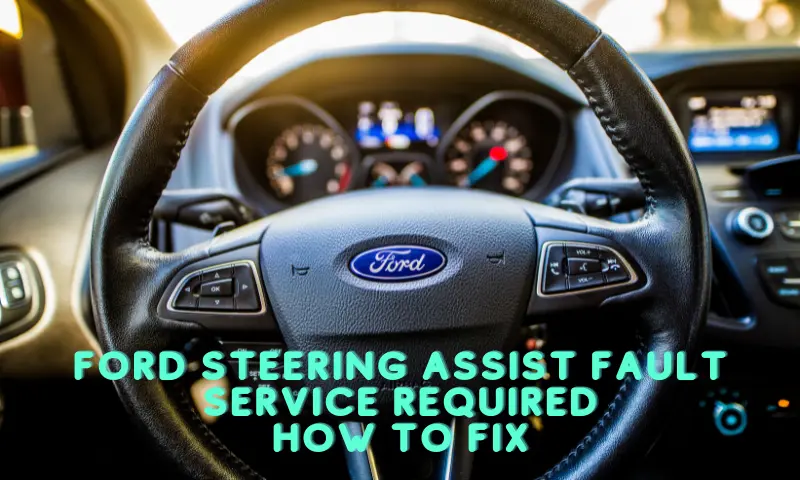After leaving the mart, you started your Ford 24.7 Coupe engine in a bid to get home before the snow started falling. Jeeze! The steering became stiff and requires too much power to move to the left or right. Within a minute, the “steering assist malfunction service required” message popped up on the dash. You stared at the car in utter exasperation. Who wouldn’t, for Pete’s sake? I understand the frustration, honestly. But what is power steering Assist? What causes the power steering assist to get deactivated and what remedy is available? Let’s take a few minutes off our schedule to read this detailed article.
What is Power Steering Assist?
With power steering technology, handling and maneuvering automobiles have become a lot easier, safer, and more convenient. How? The automobile industry has advanced from the traditional one-way approach of steering vehicles. There’s also been a shift from the solely hydraulic system to EPAS, that is, electronic power-assisted steering system.
The steering no longer relies on the power coming from the engine, as it’s the case with hydraulics. Rather, it uses the electronic system to pressure the fluid for steering. Both the power steering assist and hydraulic power steering systems serve to augment the power steering activities.
However, when the power steering fails, the power steering assist fault warning pops up. But what triggers the power steering assist fault message and what fix should you be on the lookout for? This takes me to the causes of power steering assist failure.
Causes and Fixes of Power Steering Assist Fault
Here are the most common causes of power steering assist malfunction. I’ve also included the fixes. This way, you can easily trace the issue when you see the message the next time.
Failed power Steering pump
Your Ford’s power steering system features a pump. The pump pressures the hydraulic fluid to make turning and handling easier. When the power steering pump starts to malfunction, the fluid won’t flow as it should. Thus, steering becomes harder, making vehicle control stiffer. Some of the symptoms of a failing power steering pump include noise while steering, reduced steering assistance, and fluid leaks.
What to Do
Although it’s rare for the power steering pump to fail, it’s nonetheless, not impossible. If you notice any of the symptoms identified above, you should run a scan on your car. It might be that the pump is failing and might need a replacement. I’ll always recommend that you let a professional handle this job to avoid damage to other parts of the car.
Defective steering angle sensor
A failing steering angle sensor can trigger the ‘steering assist fault service required’ message. This critical part of the power steering system is essential monitors how much and to which angle you turn the wheel. The steering angle is located behind the steering wheel and it can go bad anytime. When it happens, the sensor will start taking the wrong angle readings. As a result, the power steering assist fault will come up. Other symptoms you may experience include failed traction and poor vehicle control.
What to Do
A steering angle sensor failure requires replacing the entire sensor. A DIY for replacing the Ford steering angle sensor? Don’t. Get a dealer or a certified technician to handle it. They need to remove the steering wheel before replacing the sensor. During diagnosis, you’ll notice the error code indicating that there’s an issue with the sensor. It doesn’t matter if the wheel alignment looks pretty fine.
Low or leaking hydraulic Fluid
The steering fluid in a power steering system can go low, prompting hard maneuvering. When the fluid is low, you will notice that you’re unable to turn the vehicle as easily. A fluid leak could cause the fluid level to get low.
What to Do
If the fluid is leaking, you need to call your technician to fix the leak before topping the fluid. Changing the power steering fluid at regular intervals is a sure way to ensure. The owner’s manual will guide you on how often you should replace the fluid. Don’t forget to first perform a diagnostic test to know the exact problem.
Bad Power Steering Belt
Depending on its model, your Ford could be using V-belt or Serpentine belt. The belt helps transfer power to the power steering pump from your car’s engine pulley. Over time, the belt will wear out, making steering difficult. Apart from damage due to use, there are other reasons the belt can wear out quickly. Underside cracks, rapid sidewall wear, poor quality of the belt, and cracked bushings are some of the reasons.
What to Do
There’s nothing else to do than to replace the failing belt. If the belt finally cuts, you won’t be able to turn the steering wheel. You can change the belt of your Ford vehicle without professional service.
How to Fix failed Ford Torque Sensor
A failed torque sensor is a major trigger of the “steering assist malfunction service required” warning on Ford. You need to replace the sensor once it’s failing. You’ll need to disassemble the entire wheel. Here’s a step-by-step guide to fixing the problem.
Supplies needed
- A 90-degree pick
- A pair of pliers
- Alignment tools
- A flathead screwdriver
- A tab
Step 1: Jack up the front wheel
You need a reasonable ground clearance. Start by lifting the entire front wheel off the ground. Position the wheels straight and the steering wheel at 11 o’clock. Then remove the lower and upper steering columns. You can read the owner’s manual.
Step 2: Disassemble the bad torque sensor
Align the steering shaft keyway slot with the diamond-shaped sensor-bound markings. To do this, simply bump the two front wheels. After doing this, you can remove the bad torque sensor. To remove the sensor, pull the connecting wire up while lifting the opposite side of the sensor’s body with 90o pick. Make sure you insert the tab into the steering before fitting the tool spline into the keyway.
Step 3: Install the new torque sensor
Don’t allow any movement of the steering column to avoid misalignment. Ensure the lock pin is secure in place as you raise the sensor spline and align it with the shaft keyway slot. With your thumb, push and insert the sensor into the steering shaft as you securely seat it in place with the alignment tool.
Step 4: Realign if not
To be sure the torque sensor properly aligns, the locking pin should be inside the window. The pin shouldn’t touch any side of the sensor. Otherwise, you’ll need to realign the torque sensor.
FAQs
How much does it cost to fix the Ford steering assist error?
There are no hard and fast rules on this. The model of your Ford, the faulty parts, and the extent of damage are factors to consider. On average, however, you’ll cough out between $800 and $1000. Parts may cost between $700, while the labor cost estimate can be around $250.
Is Power Steering assist fault service warming severe?
Yes, it’s severe. You shouldn’t underrate the damage it can cause to your car and the safety risk it portends. But do you need to panic? No, but it requires an instant fix. Car error warnings aren’t intended for fun. Imagine the consequence of your car moving left when you steer or turn it to the right. I’m sure you don’t want to face it.
What are Ford’s ‘steering assist fault service required’ codes?
| Power steering Error | Ford Error Code | Possible Symptoms |
| Power Steering Overheat Sensor | B1D23 | Illuminating check engine light |
| Steering VAPS Circuit Loop Failure | C1897 | Steering assist error warning |
| Steering Angle Sensor | C1B00 | Wrong angle readings, failed traction, and steering assist error warning |
| Lost Communication With Steering Angle Sensor Module | U0126 | Steering assist error warning |
| Steering Wheel Position Sensor | C0051 | Steering assist error warning |
Final Thoughts
When next you receive the “Steering assist malfunction service required” message, you don’t need to panic. But your vehicle will need urgent attention and you shouldn’t delay taking it to your mechanic.





